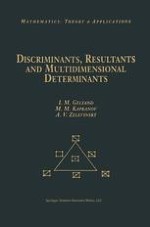“This book revives and vastly expands the classical theory of resultants and discriminants. Most of the main new results of the book have been published earlier in more than a dozen joint papers of the authors. The book nicely complements these original papers with many examples illustrating both old and new results of the theory.”
Mathematical Reviews
“Collecting and extending the fundamental and highly original results of the authors, it presents a unique blend of classical mathematics and very recent developments in algebraic geometry, homological algebra, and combinatorial theory.”
Zentralblatt Math
